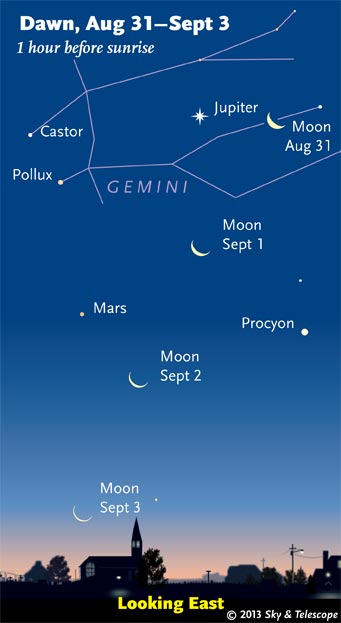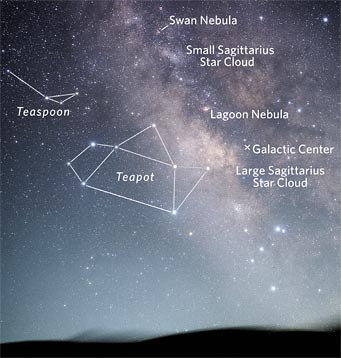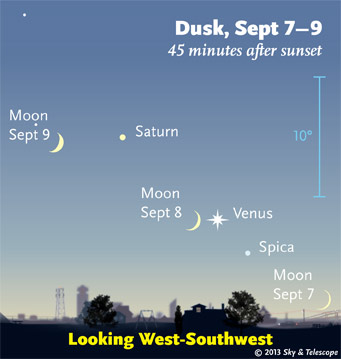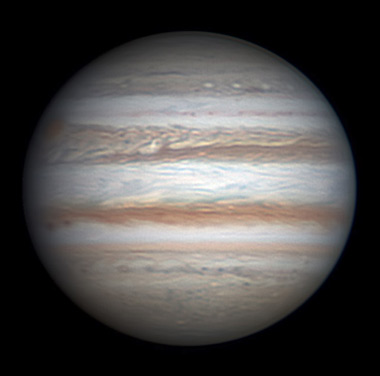
As dawn brightens, watch the waning crescent Moon passing Jupiter, Mars, and company in the eastern sky. (Positions are drawn for the middle of North America.)
Friday, August 30
Saturday, August 31
Sunday, September 1

The Sagittarius Teapot and the surrounding rich Milky Way are highest in the south right after dark at this time of year. The brightest puff of the summer Milky Way seems to rise like steam from the Teapot's spout. All of the labeled objects here and many more are good binocular targets under a dark sky. Click the image for a larger view.
Alan MacRobert
Monday, September 2
Tuesday, September 3
Wednesday, September 4
Thursday, September 5
Friday, September 6

Venus is bright, but bring binoculars to help with the faint objects low in the twilight. The Moon is positioned as it's seen from the middle of North America. The blue 10° scale is about the width of your fist held at arm's length.
Saturday, September 7
Want to become a better amateur astronomer? Learn your way around the constellations. They're the key to locating everything fainter and deeper to hunt with binoculars or a telescope.
This is an outdoor nature hobby. For an easy-to-use constellation guide covering the whole evening sky, use the big monthly map in the center of each issue of Sky & Telescope, the essential guide to astronomy. Or download our free Getting Started in Astronomy booklet (which only has bimonthly maps).
Once you have a telescope, to put it to good use you'll need a detailed, large-scale sky atlas (set of charts). The standards are the little Pocket Sky Atlas, which shows stars to magnitude 7.6; the larger and deeper Sky Atlas 2000.0 (stars to magnitude 8.5); and the even larger Uranometria 2000.0 (stars to magnitude 9.75). And read how to use sky charts with a telescope.
You'll also want a good deep-sky guidebook, such as Sue French's Deep-Sky Wonders collection (which includes its own charts), Sky Atlas 2000.0 Companion by Strong and Sinnott, the bigger Night Sky Observer's Guide by Kepple and Sanner, or the beloved if dated Burnham's Celestial Handbook.
This Week's Planet Roundup

We're getting good looks at Jupiter again now that it's climbing higher in the east during early dawn. "Seeing was excellent this morning!" writes Philippine imager Christopher Go September 3rd.
His fine image here shows the Great Red Spot disappearing around the preceding limb. The whitish turbulence following behind the spot has widened and lengthened since last we saw. A small white outbreak is occurring near where the turbulence rubs against the brownish South Equatorial Belt. South here is up. The North Equatorial Belt remains plainly redder than its southern equivalent. Don't expect visual views this crisp and vivid in any telescope!
Mercury is hidden in the glare of sunset.
Venus (magnitude –4.0) shines brightly low in the west in evening twilight, far below Arcturus. Look a little to its left for much fainter Spica early in the week, then watch Venus close in on Spica every day. It passes less than 2° above Spica on September 5th. Binoculars help. Look too for Saturn about 14° upper left of Spica.
Mars and Jupiter shine in the east before and during dawn. Jupiter, in Gemini, is the highest and brightest (magnitude –2.0). Look for fainter Mars (magnitude +1.6, in Cancer) increasingly far to Jupiter's lower left. Off to Mars's right shines Procyon, somewhat brighter.
Uranus (magnitude 5.7, in Pisces) and Neptune (magnitude 7.8, in Aquarius) are well up toward the southeast by 11 p.m. Finder charts for Uranus and Neptune.
All descriptions that relate to your horizon — including the words up, down, right, and left — are written for the world's mid-northern latitudes. Descriptions that also depend on longitude (mainly Moon positions) are for North America. Eastern Daylight Time (EDT) equals Universal Time (also known as UT, UTC, or GMT) minus 4 hours.
Like This Week's Sky at a Glance? Watch our SkyWeek TV short, also playing on PBS.
To be sure to get the current Sky at a Glance, bookmark this URL:
http://SkyandTelescope.com/observing/ataglance?1=1
If pictures fail to load, refresh the page. If they still fail to load, change the 1 at the end of the URL to any other character and try again.
 0
0
Comments
You must be logged in to post a comment.